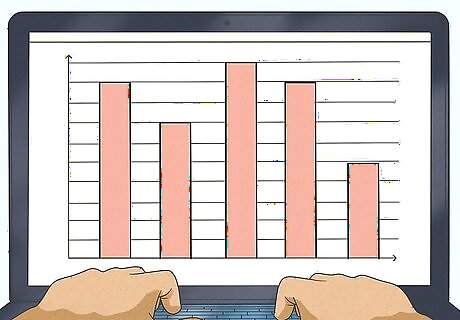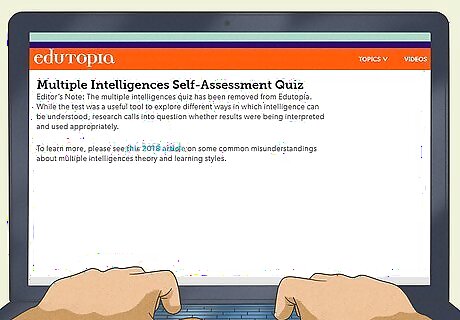
views
Establishing a Study Routine

Find an ideal study environment. Finding a quiet area free from distractions is integral to productive studying and successful learning. Over time, the mind will associate actions and outcomes with environments and adjust its functions accordingly. Establishing a regular study spot, by this logic, will condition your brain to focus and retain information better in this setting. If you don't already have a preferred study space, some choices to consider are: The library A park A quiet café or restaurant

Schedule study time. To manage your time effectively and learn as much as possible, schedule blocks of time during the week to be devoted to studying and review. These study blocks should be 50 minutes long, or shorter if you lose concentration earlier than that. Fit these appointments around the rest of your schedule, but aim to hold them at times of the day when you are most productive. For example, if you find that you are most productive in the evening, schedule your study time during those particular hours. If you are more productive in the morning, schedule some study time before class.

Take short breaks. It's important to take short breaks every now and then so you can come back to your work refocused. For example, after each 50-minute study period, spend 5-10 minutes stretching, walking around, or doing another calming activity that takes your mind off your work. Moving around can help you get ready to sit still for the next study period.

Prioritize learning. To be a successful learner, you must put studying before other commitments when necessary. If it comes down to a choice, extracurricular activities, social engagements, and fun hobbies must come second so that your studies can get your full attention. Identify the distractions that keep you from studying the most and work out a way to schedule them in during your free time, or to keep them from being a hindrance to your work. For instance, if social media is a distraction while you are trying to study, download an app to block it out (e.g. Freedom, a Windows, Mac, and Android app which keeps users from connecting to the internet for up to 8 hours).

Use the summarization method. As you study, use the summarization method to cement your learning. At the end of a unit, chapter, or study session, write out a summary of what you've learned, which can also serve as notes to review later. This process will allow you to re-evaluate and retain the knowledge that you have absorbed, and pinpoint certain points that you haven't grasped fully. For example, after reading a chapter in a U.S. History textbook, you could summarize the Eisenhower Era to reinforce what you learned. Another method of summarizing is to write a quick, single-sentence summary after each paragraph. Try to do this in the margins, if possible.

Try practice testing. An effective method of learning new material is frequent practice testing, or self-evaluation, to gauge your knowledge. As you read or study, compile a list of questions to quiz yourself on the material later. You can also look online for test preparation resources like trivia and practice quizzes, available across different subjects, age groups, and learning levels. For instance, the Ohio Department of Education website provides practice tests and sample test items in different subjects for grade 3-12. Create your own tests. Think up possible test questions, and write them down, along with the answers on the back. Try to answer your test questions the next day. EXPERT TIP Joseph Meyer Joseph Meyer Math Teacher Joseph Meyer is a High School Math Teacher based in Pittsburgh, Pennsylvania. He is an educator at City Charter High School, where he has been teaching for over 7 years. Joseph is also the founder of Sandbox Math, an online learning community dedicated to helping students succeed in Algebra. His site is set apart by its focus on fostering genuine comprehension through step-by-step understanding (instead of just getting the correct final answer), enabling learners to identify and overcome misunderstandings and confidently take on any test they face. He received his MA in Physics from Case Western Reserve University and his BA in Physics from Baldwin Wallace University. Joseph Meyer Joseph Meyer Math Teacher When doing practice problems, promptly check to see if your answers are correct. Use worksheets that provide answer keys for instant feedback. Discuss answers with a classmate or find explanations online. Immediate feedback will help you correct your mistakes, avoid bad habits, and advance your learning more quickly.

Look for connections. A good way to absorb learning material is to connect it to other subjects that you relate to, particularly things that might seem unrelated on the surface. Apply the principles of a domain that you are well-versed in to the topic at hand and write out a brief argument, for your own purposes, about why these two areas are similar. The process of forging these links will provide a more in-depth survey of what you're studying and develop associations that will make things easier to remember. As an example, if you are well-versed in auto-mechanics and enjoy fixing cars, write about different branches of government as if they were various part of a car, and note how they work together to make things run.

Discuss what you've learned with others. Talking about what you've learned is a great way to help you remember the information. Have a discussion with friends or family members about important concepts you're learning about. You could even arrange a study group with other classmates to review the material from class.
Figuring Out Your Learning Style

Use visual learning techniques. To see if a visual style of learning suits you best, try different methods that favor seeing and observing things. Watch demonstrations of things in person or online (e.g. a YouTube video detailing how to fix a leaky pipe), or enhance your reading by highlighting text or making note cards. Other visual learning techniques may include: Consulting maps, graphs, or charts Making lists Drawing illustrations Using post-it notes

Experiment with hands-on learning. Determine if tactile learning is the best fit for you by getting involved with a topic that you are learning about. For example, if you are learning about a city's history, visit some of the key landmarks that you read about (e.g. visiting the Mark Twain House in Connecticut while learning about the author). Some other types of hands-on learning methods to try are: Interviewing people about a subject (e.g. interviewing a veteran about their experience in the armed forces) Acting things out (e.g. pretending to be a character from a historical text) Conduct studies or experiments (e.g. growing a plant as a science project)

Try auditory learning. See if auditory learning works for you by seeking spoken instructions or explanations about learning material. Try audio books or taped lectures as a means to learn about something new (for instance, learn about anthropology with audio resources). Alternatively, seek out experts or fellow learners to discuss a topic with and share ideas.

Take an online quiz to determine your learning style. There are quizzes online that can help you figure out how you learn best. In addition to trying out each learning style, it may be helpful to utilize a quiz or 2 and see if the outcome matches up with what kind of learning style you think you have. For instance, you can take a learning style quiz at https://www.edutopia.org/multiple-intelligences-assessment.
Keeping Your Mind Sharp

Get enough sleep. Not getting enough sleep can affect your concentration and cause memory problems, hindering your learning process. A healthy sleep schedule should be kept up as lost sleep has a cumulative effect on your mind and body. As a general rule, the required amount of sleep for optimal functioning is: 9-11 hours a day for children 8.5-9.5 hours a day for teenagers 7-9 hours a day for adults

Eat a healthy diet. As a general rule, eating healthy will improve your overall well-being, both mentally and physically. Improve your capacity to learn by consuming healthy, “smart” foods that aid with concentration. Make sure to eat a well-balanced breakfast every day, avoid high fat foods, and try to add learning-friendly foods to your diet, such as: Omega 3-rich fish (e.g. salmon) Whole grains Avocados Blueberries Dark chocolate

Exercise regularly. Regular exercise is a key component to concentration and learning potential. If possible, exercise right before studying, which will raise your focus for 2-3 hours. If your concentration starts to fade while reading or studying, take a 15 minute exercise break to renew your energy (e.g. a quick walk around the block). Exercise also releases endorphins and serotonin, which boost mood and fight depression. You don't have to bust out the weights or sports equipment. A brisk walk or jog around the block will do.

Communicate with your teachers. Get the best learning experience possible by keeping an open line of communication with your teachers. Ask questions at appropriate times (e.g. after class), visit during office hours, and follow-up by email to confirm that you have absorbed what they told you. Reaching out will let a teacher know that you appreciate their time and wisdom, and that you should be taken seriously. EXPERT TIP Joseph Meyer Joseph Meyer Math Teacher Joseph Meyer is a High School Math Teacher based in Pittsburgh, Pennsylvania. He is an educator at City Charter High School, where he has been teaching for over 7 years. Joseph is also the founder of Sandbox Math, an online learning community dedicated to helping students succeed in Algebra. His site is set apart by its focus on fostering genuine comprehension through step-by-step understanding (instead of just getting the correct final answer), enabling learners to identify and overcome misunderstandings and confidently take on any test they face. He received his MA in Physics from Case Western Reserve University and his BA in Physics from Baldwin Wallace University. Joseph Meyer Joseph Meyer Math Teacher Review basic concepts before diving into advanced topics. Identifying the gaps in your knowledge helps you avoid difficulties later on. Take an assessment or get your teacher's advice on where you can improve. Practice targeted exercises to build a strong foundation so you can confidently tackle new lessons.

Set goals. Setting clear goals for your learning process will keep you motivated and organized. Be realistic about your goals in terms of time and complexity. For example, if you want to learn the theoretical component of how to drive, aim to read and retain one chapter of the driving manual per week.




















Comments
0 comment